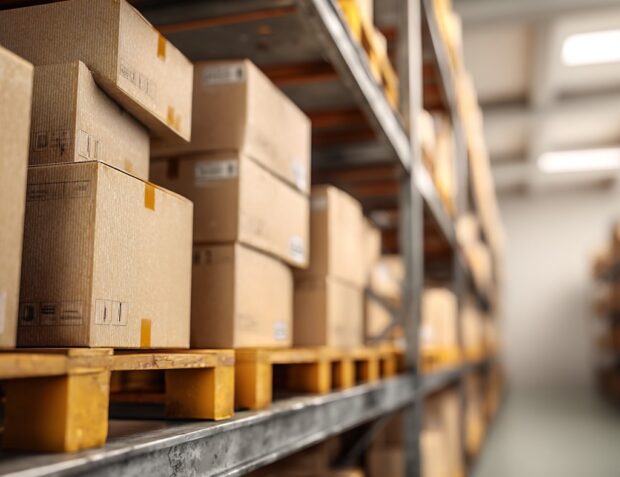Scaling an online shop is about more than just getting more orders – it’s about fulfilling them faster, more accurately, and with fewer errors as volume grows. In 2025, when consumer expectations are shaped by giants like Amazon, your warehouse operations can make or break your e-commerce success.
If your inventory isn’t organized, your pickers aren’t efficient, or your packing process is slow, it doesn’t matter how good your marketing is – customers will leave after one bad fulfillment experience.
To successfully scale, your warehouse needs to evolve from a simple storage space into a streamlined logistics hub.
That means adopting clear operational standards, investing in smart systems, and sometimes outsourcing key processes to maintain efficiency.
Step 1: Organize Inventory Based on Real Movement, Not Guesswork

Many shops start out storing products based on what fits where. But once you begin scaling, this leads to confusion, slower pick times, and higher chances of mis-picks.
Instead, organize inventory using ABC inventory analysis – a method that prioritizes items based on how often they sell.
| Category | Movement Frequency | Storage Location Strategy |
| A | High | Nearest to the packing station, eye level |
| B | Medium | Middle racks, moderate access |
| C | Low | Top/bottom shelves or the back of the warehouse |
Software like Zoho Inventory or Cin7 can help automatically categorize products based on historical sales.
Step 2: Use a Barcode System and Track Everything Digitally

When you’re fulfilling a few dozen orders a week, it’s easy to eyeball inventory. But once you start moving hundreds of products daily, manual tracking breaks down fast.
One mislabeled SKU or forgotten return can ripple across your entire operation.
Implementing a barcode or QR-based system is a non-negotiable upgrade. With scanners and warehouse management software (WMS), you can:
- Track real-time inventory levels
- Instantly verify picks and prevent packing mistakes
- Reduce human error during stock receiving or returns
WMS platforms like ShipHero, SkuVault, and Fishbowl are specifically designed for e-commerce warehouses.
They integrate with platforms like Shopify, Amazon, and WooCommerce and help manage everything from inbound shipments to last-mile delivery status.
Step 3: Build Scalable Pick-Pack-Ship Processes

When sales spike – during holiday seasons, viral moments, or product launches – your warehouse flow must hold up.
That starts with defining repeatable, scalable processes. The pick-pack-ship workflow should be broken into distinct zones and roles:
- Picking – Staff gathers items based on pick lists or digital scanners
- Packing – Products are quality-checked and securely packaged
- Labeling & Shipping – Shipping labels are printed, and orders are dispatched
Batch picking (picking multiple orders in one route) becomes much more efficient than single-order picking at scale.
You can also group orders by shipping method (e.g., USPS vs FedEx) to speed up carrier hand-offs.
Clear signage, walking paths, and fixed workstations improve productivity and reduce confusion during high-volume days.
Even something simple like labeling packing tables by order type (international, fragile, etc.) helps.
Step 4: Partner with a Prep Center for Flexibility and Growth

As your store grows, there may come a point where managing everything in-house becomes a bottleneck. That’s where prep center services become extremely valuable.
A prep center acts as an outsourced warehouse and fulfillment service, receiving inventory, inspecting, labeling, bundling, and shipping products on your behalf.
Using a prep center gives your business:
- Faster scaling without warehouse expansion
- Lower labor overhead, especially for small teams
- Access to regional hubs, reducing delivery times
- Experience with platforms like Amazon FBA, which require strict labeling and packing standards
If you’re running an FBA store, a prep center can handle everything from sticker removal to poly bagging to palletization.
For DTC brands, they offer flexibility when entering new markets – especially international ones – without needing to set up local warehouses.
Look for prep centers with fast turnaround times, integrations with your platform, and transparent pricing. Some well-known ones in the U.S. include:
| Prep Center | Location(s) | Services Offered |
| My FBA Prep | Nationwide (USA) | FBA prep, DTC shipping, custom projects |
| Deliverr (by Flexport) | Major US cities | 1–2 day shipping zones, marketplace fulfillment |
| ShipBob | Global | DTC fulfillment, B2B wholesale, returns |
Step 5: Forecast Inventory Like a Real Operation
When you scale, inventory errors become costly. Overstocking ties up cash and warehouse space. Understocking leads to missed sales and angry customers.
The key is accurate demand forecasting, using data instead of gut feeling.
Modern WMS platforms pull historical data from your store and factor in:
- Sales trends by season
- Product lifecycle (launch, peak, decline)
- Promotion impact
- Supplier lead times
This data helps you project how much inventory to reorder – and when. Platforms like Inventory Planner, ForecastRx, or Shopify Analytics give predictive insights so you can make proactive decisions.
Inventory forecasting is also how you prepare for Black Friday, product launches, or seasonal spikes.
Instead of reacting, you pre-position the right stock levels and staff accordingly.
Step 6: Design for Returns From the Start
Returns are part of e-commerce, not an exception. A poor return process can overwhelm your warehouse and damage your reputation.
But if you design your return system early, it becomes a smooth operation.
Steps include:
- Assigning a separate receiving area for returns
- Creating a digital RMA (Return Merchandise Authorization) system
- Inspecting returned products and sorting them into restock, refurbish, or discard
- Updating inventory automatically when restockable items are scanned
Return software like Loop Returns or Returnly integrates with major e-commerce platforms and helps manage refunds, exchanges, and restocking with minimal manual work.
Step 7: Train Your Team and Define SOPs

Scaling your warehouse isn’t just about tools and tech – it’s also about people and consistency. Every person on your warehouse team should follow the same standard operating procedures (SOPs) for receiving, picking, packing, and safety.
This is how you reduce training time, ensure uniform quality, and prevent mistakes when you hire seasonal or new staff.
Document processes with photos, clear steps, and who is responsible for what. Use tools like Notion, Google Drive, or Trainual to share SOPs and update them as workflows evolve.
Also, invest in training. If your team doesn’t understand the impact of their role on the customer experience, errors will multiply fast.
A picker who understands the consequences of sending the wrong item will double-check every SKU.
Final Thoughts
Most online shops think of warehousing as just “where the product sits.” But in 2025, warehouse operations are a competitive advantage.
They affect speed, customer satisfaction, return rate, shipping costs, and your ability to scale without chaos.
Whether you’re fulfilling in-house or working with a prep center, these practices make your warehouse scalable:
- Organize based on sales velocity
- Use barcodes and digital tracking
- Standardize pick-pack-ship processes
- Forecast inventory accurately
- Build a return system, not a panic response
- Document everything
- Train like your customer experience depends on it – because it does
As your store grows, your warehouse becomes a system, not a room. When done right, it helps you scale with less stress, fewer errors, and more profit, because fulfillment becomes a well-oiled, invisible machine behind every sale.
 Jewel Beat
Jewel Beat

